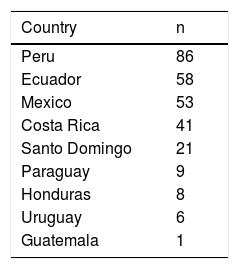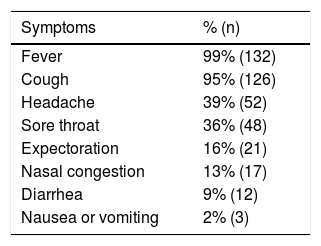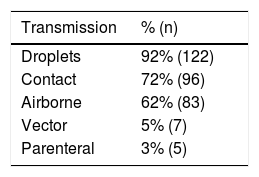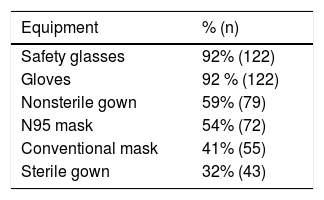After the World Health Organization declared the COVID-19 outbreak a pandemic, the number of patients with confirmed SARS-CoV-2 infection (COVID-19) has increased exponentially, and gastroenterologists and other specialists most likely will be involved in the care of those patients.
AimTo evaluate the knowledge Latin American gastroenterologists and endoscopists (staff physicians and residents) have about the characteristics of COVID-19, as well as the prevention measures to be taken during endoscopic procedures.
Materials and methodsWe conducted a cross-sectional study that included gastroenterologists and endoscopists from 9 Latin American countries. An electronic questionnaire was applied that was designed to evaluate the knowledge of symptoms, risk groups for severe disease, prevention measures, and the reprocessing of endoscopes utilized in patients with COVID-19.
ResultsInformation was obtained from 133 physicians. Ninety-five percent of them correctly identified the most frequent symptoms of the virus, and 60% identified the 3 risk groups for severe disease. Sixty-six percent of those surveyed did not consider it necessary to use standard precautions during endoscopic procedures, and 30% did not consider contact precautions necessary. Forty-eight percent of the participants surveyed were not familiar with the protocol for reprocessing the endoscopes utilized in patients with COVID-19.
ConclusionThe majority of the gastroenterologists and endoscopists surveyed were familiar with the signs and symptoms of COVID-19 and the populations at risk for complications. There was a lack of knowledge about prevention measures (during clinical care and endoscopic procedures) and the reprocessing of endoscopic equipment by 70% and 48%, respectively, of those surveyed. Dissemination and teaching strategies that increase the knowledge of specific biosafety measures must be carried out.
Después de que la Organización Mundial de la Salud (OMS) declaró a la enfermedad por SARS-CoV-2 (COVID-19) pandemia, el número de pacientes con infección confirmada ha incrementado exponencialmente. Es muy probable que gastroenterólogos y otros especialistas se involucren en la atención de estos pacientes.
ObjetivoEvaluar el conocimiento de gastroenterólogos y endoscopistas (adscritos y residentes) en Latinoamérica sobre las características de COVID-19 y las medidas de prevención durante procedimientos endoscópicos.
Material y métodosRealizamos un estudio transversal que incluyó a gastroenterólogos y endoscopistas de nueve países de Latinoamérica. Se aplicó un cuestionario electrónico diseñado para valorar conocimientos sobre síntomas, grupos de riesgo para enfermedad grave, medidas de prevención y reprocesamiento de endoscopios utilizados en pacientes con COVID-19.
ResultadosSe obtuvo información de 133 médicos, 95% de los encuestados identificó correctamente los síntomas más frecuentes y 60% identificó los tres grupos de riesgo para enfermedad grave. El 66% no consideró necesario usar precauciones estándar durante procedimientos endoscópicos y 30% no consideró necesarias las precauciones de contacto. El 48% desconoció el protocolo para reprocesamiento de los endoscopios en pacientes con COVID-19.
ConclusiónLos signos y síntomas de COVID-19 y las poblaciones de riesgo de complicaciones son conocidos por la mayoría de los gastroenterólogos y endoscopistas. El conocimiento sobre medidas de prevención (durante atención clínica y procedimientos endoscópicos), así como el reprocesamiento del equipo endoscópico son desconocidos por 70 y 48% de los encuestados respectivamente. Se deben realizar estrategias de difusión y enseñanza que incrementen el conocimiento sobre estos aspectos de bioseguridad.
Coronaviruses are a group of enveloped single-stranded RNA viruses, seven strains of which have been described as capable of infecting humans, including that of severe acute respiratory syndrome coronavirus 2 (SARS-CoV-2). Since the identification of the first cases of acute respiratory disease caused by the SARS-CoV-2 strain in December 2019 in the city of Wuhan, China, the number of reported cases has grown exponentially worldwide.1,2
In January 2020, the World Health Organization (WHO) declared the outbreak of coronavirus disease 2019 (COVID-19) a public health emergency, and a pandemic on March 11, 2020.2 By March 26, there were 462,684 confirmed cases and 20,834 deaths registered across the globe. Europe is the region with the highest number of cases, registered at 250,287, followed by the Western Pacific region, with 99,058 cases. In the region of Latin America, the number of patients with confirmed SARS-CoV-2 infection has increased from 5 to 8,296 cases, from March 1 to March 26.3
Knowledge about the pathogeny, natural history, virulence, and transmission of the virus, as well as prevention measures, is limited, but constantly increasing through publications from the countries and centers in which the first cases occurred (e.g., China, South Korea). Those reports have established the bases upon which the different governments and health departments of the Asian, European, and American countries and international agencies have proposed surveillance, diagnostic, and healthcare guidelines for those patients. In the area of gastroenterology, the American societies of gastroenterology, hepatology and endoscopy (AASLD, ACG, AGA, and ASGE) emitted a joint communication on March 154 and the European societies (ESGE and ESGENA) issued their report 3 days earlier on March 12.5Table 1 shows the main recommendations.
Recommendations for the performance of endoscopic procedures, based on AGA and ASGE guidelines.
| Procedure scheduling | All elective/non-urgent procedures should be postponed until the health emergency is over. |
|---|---|
| Prevention and control precautions | The virus is transmitted by contact, droplets, and via the airborne route (in aerosol-generating procedures), therefore standard, contact, and airborne precautions should be taken. |
| Use of protective equipment | Gloves, safety glasses, nonsterile gowns, and high efficiency masks (e.g., N95) should be worn. |
| Procedure location | The procedure should be performed in the patient’s room, but if that is not possible, it should be carried out in a predetermined area, with doors closed and adequate ventilation, and the minimum number of personnel. |
| Reprocessing of endoscopic equipment | Standard reprocessing is recommended, using high level disinfectants (e.g., 2% glutaraldehyde for 20-40 minutes or 0.55% ortho-phthalaldehyde for 12 minutes), after adequate cleaning of the materials. |
Due to the elevated rate of contagion and the diversity of extrapulmonary symptoms, specialists in pneumology, critical medicine, emergency medicine, and infectious diseases will not exclusively be in charge of those patients. The infection has been reported to cause gastrointestinal symptoms in up to 50% of the cases, and the most frequent are anorexia (78%), diarrhea (34%) and altered liver enzymes (22%).6,7 Therefore, gastroenterologists will surely participate in the medical care of certain cases. The reported transmission routes, based on other viruses, are by contact and droplets.8 SARS-CoV-2 is detectable in aerosols for up to 3 hours, on copper for 4 hours, and on plastic and stainless steel for 72 hours.9 Thus, it is important to know the adequate reprocessing of endoscopic equipment, including the use of high level disinfectants.10,11
The aim of the present study was to evaluate the knowledge of Latin American gastroenterology and endoscopy professionals in relation to the characteristics of SARS-CoV-2 infection and the prevention measures recommended during patient care and the performance of endoscopic procedures, including the reprocessing of equipment utilized on patients with the disease.
Materials and methodsWe conducted a cross-sectional study on gastroenterologists and endoscopists (residents and specialists) working in public hospitals from nine Latin American countries (Mexico, Costa Rica, Ecuador, Paraguay, Peru, Guatemala, Uruguay, Honduras, and the Dominican Republic). They were invited through email or Smartphone messaging to participate in a survey and contacted by a gastroenterologist, with whom we were connected academically by telephone, at each hospital center. Each of the contact gastroenterologists distributed the questionnaires to the gastroenterologists and endoscopists at their corresponding hospital centers. The survey was conducted on March 16 and 17, 2020.
A 16-item questionnaire (annex 1) was sent to the physicians that wished to participate. It was designed to evaluate the knowledge about symptoms, groups at risk for severe disease, and prevention measures to counter the SARS-CoV-2 infection. The questionnaire included demographic and occupational information of the participants and was applied over two days utilizing Google Forms. All participation was confidential and anonymous. The number of participants was determined through convenience sampling.
The questions were designed based on published information, obtained through a search of the literature in PubMed, using the terms "COVID-19", "coronavirus", or “SARS-CoV-2”, associated with the terms: symptoms, complications, risk factors, prevention, endoscopy, and reprocessing. The search included articles published within the time frame of January 1, 2008 and March 17, 2020.
Statistical analysisDescriptive statistics were applied and the frequency of the answers to each question was calculated. The median (min-max) was utilized to describe the numerical variables, and frequencies and percentages were utilized to describe the categorical variables. The statistical analysis was carried out with SPSS version 25 software for Windows (IBM Corp., Armonk, NY, USA).
Ethical considerationsInformed consent was not required, given that no patient data appeared in the present study nor was there patient participation. Likewise, due to the lack of an intervention, maneuver, or information management, the study was considered a low-risk analysis and did not require review or approval by a local ethics committee. Even so, the present study follows the current research norms, guaranteeing confidentiality in relation to personal and identification data of the participants (all of whom were healthcare workers that participated voluntarily), as well as their anonymity. The present article contains no information that can identify the participants.
ResultsThree hundred electronic invitations were sent out and 102 gastroenterologists and 31 endoscopists responded, for a total of 133 participants. The physicians were from 9 Latin American countries: 112 from Mexico, 7 from Costa Rica, 7 from Ecuador, 2 from Guatemala, 1 from Honduras, 1 from the Dominican Republic, 1 from Peru, 1 from Uruguay, and 1 from Paraguay. Table 2 shows the number of patients with COVID-19 from each of those countries at the time of the survey. Forty-four percent of the participants (n = 58) were residents and 56% (n = 75) were specialists. The median participant age was 33 years (27-64 years) and the median number of years practicing gastroenterology was 3 (1 month-33 years). Sixty-eight percent (n = 91) of the physicians evaluated had performed at least one endoscopy in the past month.
Table 3 shows the most frequent symptoms of SARS-CoV-2 infection, according to the participants. The risk factors for severe disease most frequently identified by the physicians surveyed were age ≥ 65 years, recognized by 95% of the participants (n = 127); diabetes mellitus, by 74% (n = 98); chronic obstructive pulmonary disease by 67% (n = 89); and arterial hypertension by 66% (n = 88).
Table 4 shows the SARS-CoV-2 transmission routes identified. Sixty-eight percent (n = 90) of the physicians were aware that evidence of SARS-CoV-2 has been found in stools, blood, and respiratory secretions, but 23% (n = 31) of the participants stated that the presence of SARS-CoV-2 in respiratory secretions was the only site at which the virus was detected.
Ninety-one percent (n = 121) of the physicians surveyed recognized that endoscopic procedures were a risk for virus transmission. Table 5 shows the necessary equipment when performing an endoscopy on any patient during the pandemic, according to the physicians evaluated. There was a discrepancy on the type of mask to wear, with 41% (n = 55) answering that a conventional mask was necessary, and 54% (n = 72) that a high efficiency mask (N95) was necessary.
Fig. 1 shows the precautions for the prevention of SARS-CoV-2 transmission. Standard precautions and contact precautions were not considered necessary by 66% (n = 88) and 30% (n = 39) of the participants, respectively. Fig. 2 shows the measures for reprocessing the endoscopes and their accessories, according to the physicians evaluated. Finally, 85% (n = 113) of those surveyed considered that elective endoscopic studies should be cancelled during the pandemic.
The number of people to whom one infected person will pass SARS-CoV-2 (its Ro) has been reported at 2.5,12 which explains its easy and rapid propagation, potentiated by its capacity to survive on inert surfaces for up to 72 hours.9 It is known that carriers can be asymptomatic, who, the same as infected persons, can easily transmit the virus during the incubation period. Extrapulmonary symptoms, such as diarrhea and liver alterations, have been reported and viral RNA has also been identified in stool.13 Therefore, endoscopic procedures can be considered a high risk for infection due to the exposure to the oral cavity and respiratory and intestinal secretions with elevated viral burdens.
The present study described the current knowledge of 133 Latin American residents and specialists in gastroenterology and endoscopy about symptoms, risk groups, transmission, and endoscopic equipment reprocessing in relation to COVID-19. According to the largest case series reported so far (n = 1,099), 88.7% of the patients presented with fever during the course of the disease, 67.8% presented with cough, and 33.7% presented with sputum production.7 Gastrointestinal symptoms were observed less frequently, with nausea and vomiting in 5%, diarrhea in 3.8%,7 and abdominal pain in 2.2% of those affected.14 In our study, the majority of the participants (95%) were aware of those symptoms.
The three risk groups for severe disease described more frequently in the literature include patients above 65 years of age and patients with diabetes or hypertension, especially those treated with angiotensin-converting enzyme (ACE) inhibitors.7,14,15 In the case series by Guan et al., 15.7% of the patients fit the severe disease criteria, 5% of the patient total required admission to the ICU, and 2.3% required mechanical ventilation.7 Reported mortality varied from 1.4% to 4.1%.7,14,16,17 Two-thirds of the participants surveyed identified the risk groups correctly.
As mentioned above, SARS-CoV-2 is transmitted through contact and droplets.8 One infected person can pass the virus to close to 3 other persons, albeit that reproduction number tends to vary, according to population characteristics (age, location, sex).12 The majority of the physicians evaluated identified droplet and contact transmission but 40% did not identify airborne transmission, a route that is plausible in procedures that generate virus-containing aerosols that can remain viable for at least three hours. All upper endoscopy should be considered a procedure that has a risk for aerosolization.9
It is important to emphasize that the virus survives for at least 72 hours on plastic and stainless steel surfaces, materials that are present in the equipment and accessories utilized for endoscopic procedures.9 Fecal excretion of SARS-CoV-2 RNA has also been described in 53.4% of infected patients,13 but the probability of transmission by that route has not yet been determined.
We found that the biggest gap in knowledge was related to protection measures during and after endoscopic procedures. Two-thirds of the physicians surveyed did not consider it necessary to perform contact measures, which are essential for the prevention of SARS-CoV-2 transmission, and the majority only recognized the need for protection against droplets. However, standard, contact, and droplet precautions should be taken when performing any endoscopic procedure (hand washing and hygiene, gloves, nonsterile gown, mask, and safety glasses) during the present health emergency.9,13,18,19 If a patient has probable or confirmed SARS-CoV-2 infection and requires an endoscopic procedure, airborne transmission precautions are recommended, including wearing an N95 mask because of the aerosolization risk.4,9 The procedure should be performed in the patient’s room, but if that is not possible, then it should be carried out in a predetermined area, with doors closed and adequate ventilation. After the procedure, the room should be cleaned with 0.1% sodium hypochlorite and not be used again for at least 3 hours.9,20,21 It is also important for the minimum number of personnel to be present during the procedure.
Close to one-half of the survey participants did not know the adequate procedure for reprocessing the endoscopes and related accessories. The customary disinfection process is recommended for cleaning the equipment and is considered safe and efficient for preventing viral transmission. High level disinfectants should be used, such as 2% glutaraldehyde for 20-40 minutes or 0.55% ortho-phthalaldehyde for 12 minutes, after adequate cleaning of the materials.10,11
The current recommendation is to postpone elective procedures, whenever possible. If that is not an option, the patient should be called the day before the procedure, answer a questionnaire and stage his/her risk for infection according to manifested symptoms, to whether he/she had visited an at-risk zone, or if he/she had been in contact with an infected patient. Taking the patient’s temperature before entering the procedure room is also recommended.22
Importantly, the recommendations in the area of gastroenterology of the European and American societies were published on March 12 and 15, respectively,4,5 which was only a short time before we applied the present survey on March 16 and 17. That could be a reason for the lack of knowledge about prevention measures and endoscopic procedure management regarding COVID-19 patients. The above information reinforces the fact that information about the virus is updated on a daily basis, and therefore it is essential for physicians that could be in charge of patients with COVID-19 to keep their disease information up to date.
In conclusion, the gastroenterologists and endoscopists evaluated had an adequate level of knowledge in relation to symptoms and risk groups for severe disease. There was disinformation regarding prevention measures and managing endoscopic equipment reprocessing. The implementation of educational strategies that emphasize prevention measures and endoscope reprocessing should be considered.
Financial disclosureNo financial support was received in relation to this study/article.
Conflict of interestThe authors declare that there is no conflict of interest.
Additional material related to this article can be consulted electronically at: doi:10.1016/j.rgmx.2020.04.003.
Please cite this article as: Ruiz-Manriquez J, et al. Conocimiento sobre la infección por SARS-CoV-2 de Gastroenterólogos y Endoscopistas de Latinoamérica. Revista de Gastroenterología de México. 2020;85:288–294.












